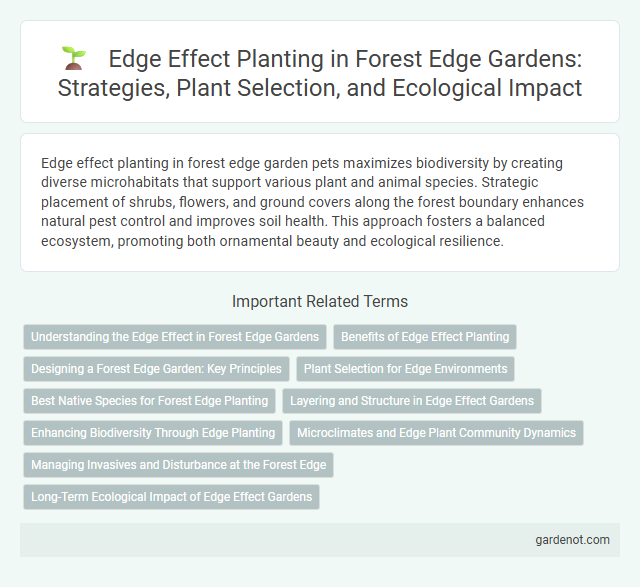Edge effect planting in forest edge garden pets maximizes biodiversity by creating diverse microhabitats that support various plant and animal species. Strategic placement of shrubs, flowers, and ground covers along the forest boundary enhances natural pest control and improves soil health. This approach fosters a balanced ecosystem, promoting both ornamental beauty and ecological resilience.
Understanding the Edge Effect in Forest Edge Gardens
Edge effect planting in forest edge gardens maximizes biodiversity by creating diverse microhabitats where forest meets open land, resulting in increased sunlight, wind exposure, and soil variation. This ecological transition zone supports a variety of plant species adapted to both shaded and sunlit conditions, enhancing pollinator activity and wildlife habitat. Understanding the edge effect promotes strategic planting techniques that improve ecosystem resilience and garden productivity.
Benefits of Edge Effect Planting
Edge effect planting enhances biodiversity by creating diverse microhabitats at the interface of forest and garden areas, attracting a wider range of wildlife and beneficial insects. This planting strategy improves ecosystem resilience, boosts pollination rates, and supports natural pest control, leading to healthier plant growth. The increased sunlight and nutrient exchange in edge zones also promote vigorous plant development and higher overall productivity.
Designing a Forest Edge Garden: Key Principles
Edge effect planting maximizes biodiversity by creating diverse microhabitats where forest meets open space, enhancing species richness and ecological interactions. Designing a forest edge garden involves layering native shrubs, understory plants, and ground covers to mimic natural transitions and support wildlife habitat. Incorporating structural diversity and selecting shade-tolerant species optimize light gradients and soil conditions, promoting resilience and ecosystem functionality.
Plant Selection for Edge Environments
Selecting native shrubs and perennial grasses enhances biodiversity and resilience in forest edge gardens by adapting well to variable light and soil conditions typical of edge environments. Incorporating a mix of sun-loving and shade-tolerant species, such as elderberry (Sambucus canadensis) and woodland sunflower (Helianthus divaricatus), supports diverse wildlife habitats and stabilizes soil. Prioritizing plants with deep root systems and drought tolerance improves soil retention and microclimate regulation, essential for sustainable edge effect planting.
Best Native Species for Forest Edge Planting
Best native species for forest edge planting include Rhododendron maximum, Cornus florida, and Ilex opaca, which thrive in transitional zones between forest interiors and open habitats. These plants enhance biodiversity by creating diverse microhabitats and supporting native wildlife such as pollinators and songbirds. Their deep root systems improve soil stability and moisture retention, making them ideal for sustainable edge effect landscaping.
Layering and Structure in Edge Effect Gardens
Layering and structure in edge effect gardens enhance biodiversity by creating diverse microhabitats through the strategic placement of plants in vertical and horizontal layers. Taller trees form the canopy, while shrubs, herbaceous plants, and ground covers fill mid and lower layers, promoting greater species interaction and resilience. This multi-layered vegetation increases sunlight interception, improves soil health, and supports various wildlife, optimizing the ecological benefits of forest edge zones.
Enhancing Biodiversity Through Edge Planting
Edge effect planting in forest edge gardens boosts biodiversity by creating diverse microhabitats where sunlight, moisture, and temperature vary. Incorporating native shrubs, flowering plants, and ground covers along the forest boundary supports pollinators, birds, and small mammals, enriching the ecosystem. Strategic layering of vegetation at the edge fosters species interactions and ecological resilience, promoting a balanced and thriving habitat.
Microclimates and Edge Plant Community Dynamics
Edge effect planting in forest edge gardens enhances biodiversity by creating diverse microclimates influenced by varying light, temperature, and humidity conditions. These microclimates support specialized edge plant communities that exhibit dynamic interactions, such as competition and facilitation, adapting uniquely to the transitional zone. Understanding edge plant community dynamics and microclimate gradients is essential for optimizing species selection and promoting ecological resilience in forest edge habitats.
Managing Invasives and Disturbance at the Forest Edge
Managing invasives and disturbance at the forest edge requires strategic edge effect planting to maintain biodiversity and ecosystem health. Selecting native species that outcompete invasive plants reduces their spread, while buffer zones stabilize soil and mitigate disturbance impacts. Monitoring and adaptive management ensure the forest edge remains resilient against threats from invasive species and environmental changes.
Long-Term Ecological Impact of Edge Effect Gardens
Edge effect planting in forest edge gardens enhances biodiversity by creating microhabitats that support diverse plant and animal species. This ecological strategy promotes species richness and resilience, contributing to ecosystem stability over decades. Long-term impacts include improved nutrient cycling and increased habitat connectivity, fostering sustainable forest landscape dynamics.
Edge effect planting Infographic

 gardenot.com
gardenot.com